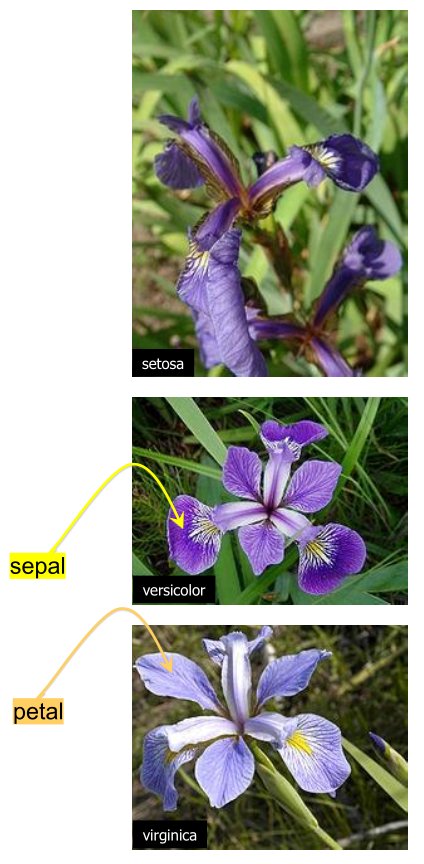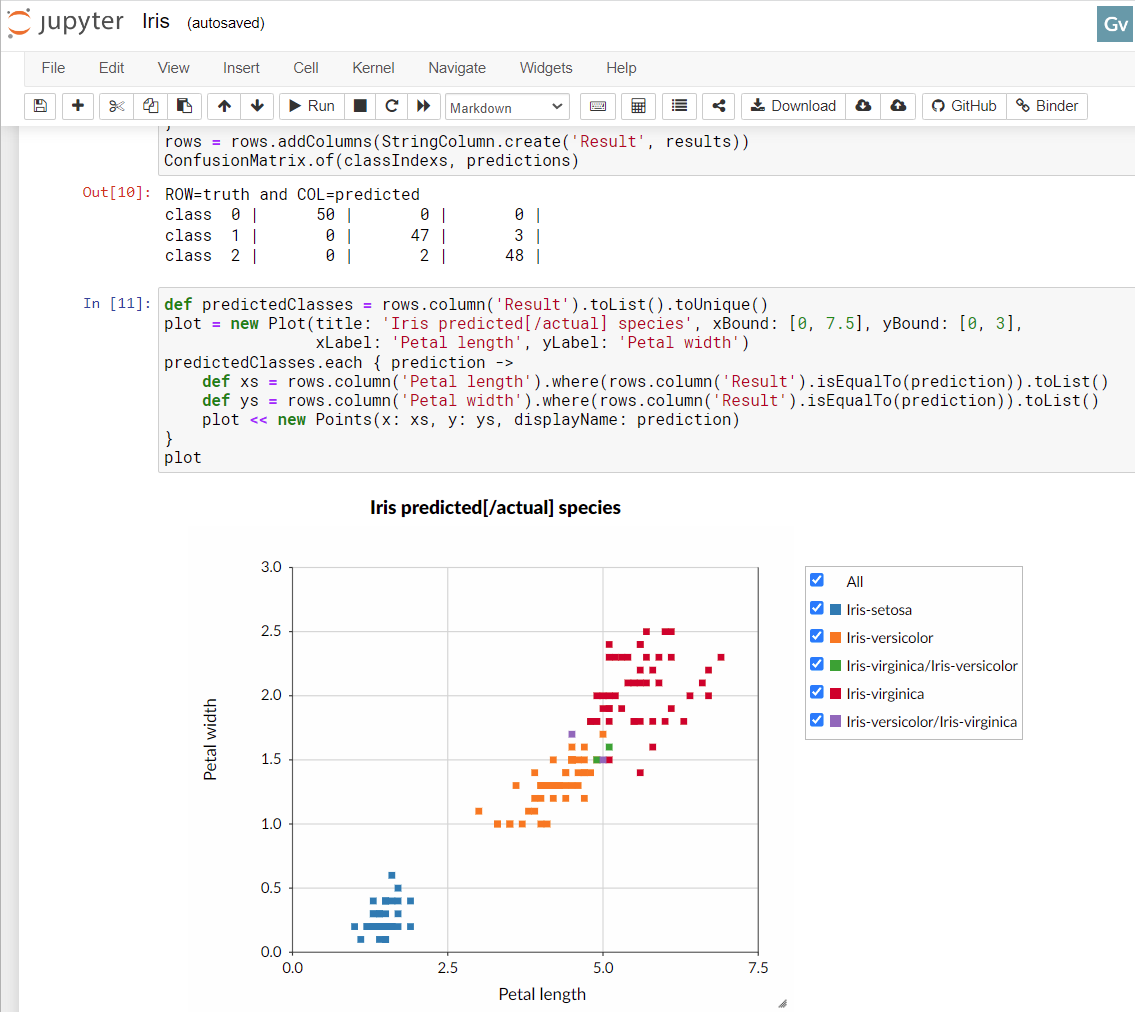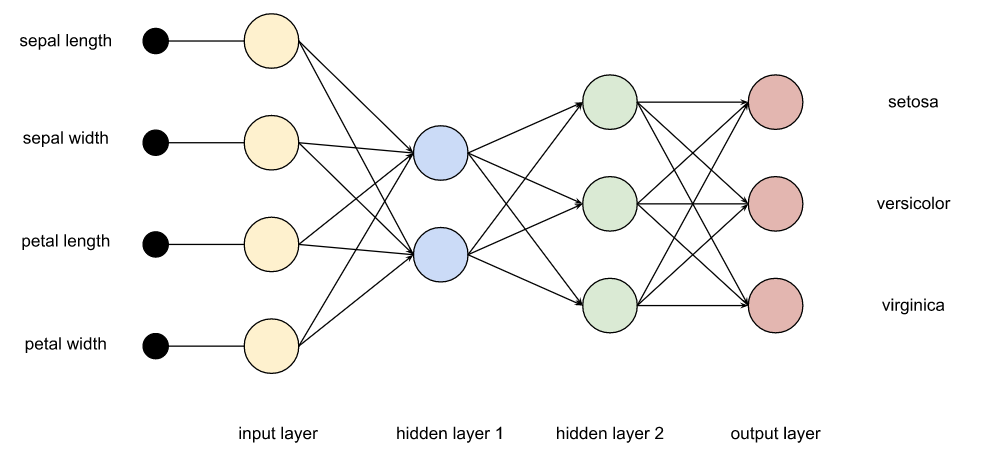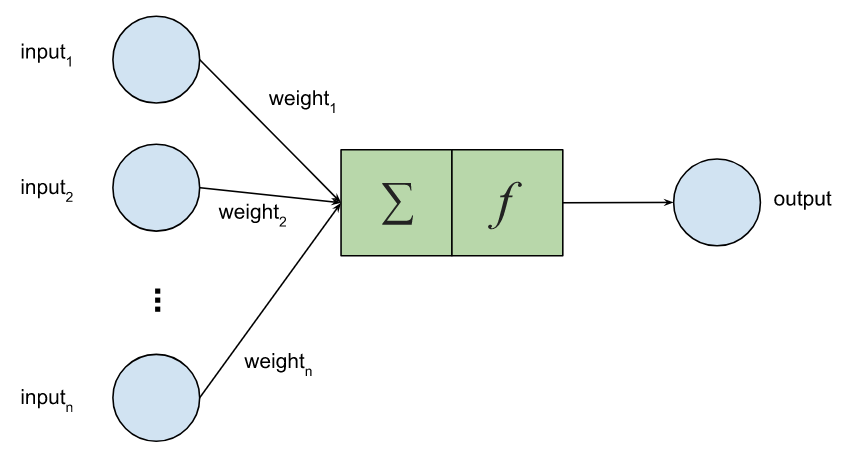Classifying Iris Flowers with Deep Learning, Groovy™ and GraalVM
Published: 2022-06-25 10:52AM (Last updated: 2022-06-27 11:16AM)
 A classic data science dataset captures flower characteristics of Iris flowers.
It captures the width and length of the sepals and petals for three species (Setosa, Versicolor, and Virginica).
A classic data science dataset captures flower characteristics of Iris flowers.
It captures the width and length of the sepals and petals for three species (Setosa, Versicolor, and Virginica).
The Iris project in the groovy-data-science repo is dedicated to this example. It includes a number of Groovy scripts and a Jupyter/BeakerX notebook highlighting this example comparing and contrasting various libraries and various classification algorithms.
| Technologies/libraries covered | |
|---|---|
Data manipulation |
|
Classification |
|
Visualization |
|
Main aspects/algorithms covered |
Reading csv, dataframes, visualization, exploration, naive bayes, logistic regression, knn regression, softmax regression, decision trees, support vector machine |
Other aspects/algorithms covered |
Feel free to browse these other examples and the Jupyter/BeakerX notebook if you are interested in any of these additional techniques.

For this blog, let’s just look at the Deep Learning examples. We’ll look at solutions using Encog, Eclipse DeepLearning4J and Deep Netts (with standard Java and as a native image using GraalVM) but first a brief introduction.
Deep Learning
Deep learning falls under the branches of machine learning and artificial intelligence. It involves multiple layers (hence the "deep") of an artificial neural network. There are lots of ways to configure such networks and the details are beyond the scope of this blog post, but we can give some basic details. We will have four input nodes corresponding to the measurements of our four characteristics. We will have three output nodes corresponding to each possible class (species). We will also have one or more additional layers in between.

Each node in this network mimics to some degree a neuron in the human brain. Again, we’ll simplify the details. Each node has multiple inputs, which are given a particular weight, as well as an activation function which will determine whether our node "fires". Training the model is a process which works out what the best weights should be.

The math involved for converting inputs to output for any node isn’t too hard. We could write it ourselves (as shown here using matrices and Apache Commons Math for a digit recognition example) but luckily we don’t have to. The libraries we are going to use do much of the work for us. They typically provide a fluent API which lets us specify, in a somewhat declarative way, the layers in our network.
Just before exploring our examples, we should pre-warn folks that while we do time running the examples, no attempt was made to rigorously ensure that the examples were identical across the different technologies. The different technologies support slightly different ways to set up their respective network layers. The parameters were tweaked so that when run there was typically at most one or two errors in the validation. Also, the initial parameters for the runs can be set with random or pre-defined seeds. When random ones are used, each run will have slightly different errors. We’d need to do some additional alignment of examples and use a framework like JMH if we wanted to get a more rigorous time comparison between the technologies. Nevertheless, it should give a very rough guide as to the speed to the various technologies.
Encog
Encog is a pure Java machine learning framework that was created in 2008. There is also a C# port for .Net users. Encog is a simple framework that supports a number of advanced algorithms not found elsewhere but isn’t as widely used as other more recent frameworks.
The complete source code for our Iris classification example using Encog is here, but the critical piece is:
def model = new EncogModel(data).tap {
selectMethod(data, TYPE_FEEDFORWARD)
report = new ConsoleStatusReportable()
data.normalize()
holdBackValidation(0.3, true, 1001) // test with 30%
selectTrainingType(data)
}
def bestMethod = model.crossvalidate(5, true) // 5-fold cross-validation
println "Training error: " + pretty(calculateRegressionError(bestMethod, model.trainingDataset))
println "Validation error: " + pretty(calculateRegressionError(bestMethod, model.validationDataset))When we run the example, we see:
paulk@pop-os:/extra/projects/iris_encog$ time groovy -cp "build/lib/*" IrisEncog.groovy 1/5 : Fold #1 1/5 : Fold #1/5: Iteration #1, Training Error: 1.43550735, Validation Error: 0.73302237 1/5 : Fold #1/5: Iteration #2, Training Error: 0.78845427, Validation Error: 0.73302237 ... 5/5 : Fold #5/5: Iteration #163, Training Error: 0.00086231, Validation Error: 0.00427126 5/5 : Cross-validated score:0.10345818553910753 Training error: 0.0009 Validation error: 0.0991 Prediction errors: predicted: Iris-virginica, actual: Iris-versicolor, normalized input: -0.0556, -0.4167, 0.3898, 0.2500 Confusion matrix: Iris-setosa Iris-versicolor Iris-virginica Iris-setosa 19 0 0 Iris-versicolor 0 15 1 Iris-virginica 0 0 10 real 0m3.073s user 0m9.973s sys 0m0.367s
We won’t explain all the stats, but it basically says we have a pretty good model with low errors in prediction. If you see the green and purple points in the notebook image earlier in this blog, you’ll see there are some points which are going to be hard to predict correctly all the time. The confusion matrix shows that the model predicted one flower incorrectly on the validation dataset.
One very nice aspect of this library is that it is a single jar dependency!
Eclipse DeepLearning4j
Eclipse DeepLearning4j is a suite of tools for running deep learning on the JVM. It has support for scaling up to Apache Spark as well as some integration with python at a number of levels. It also provides integration to GPUs and C/++ libraries for native integration.
The complete source code for our Iris classification example using DeepLearning4J is here, with the main part shown below:
MultiLayerConfiguration conf = new NeuralNetConfiguration.Builder()
.seed(seed)
.activation(Activation.TANH) // global activation
.weightInit(WeightInit.XAVIER)
.updater(new Sgd(0.1))
.l2(1e-4)
.list()
.layer(new DenseLayer.Builder().nIn(numInputs).nOut(3).build())
.layer(new DenseLayer.Builder().nIn(3).nOut(3).build())
.layer(new OutputLayer.Builder(LossFunctions.LossFunction.NEGATIVELOGLIKELIHOOD)
.activation(Activation.SOFTMAX) // override activation with softmax for this layer
.nIn(3).nOut(numOutputs).build())
.build()
def model = new MultiLayerNetwork(conf)
model.init()
model.listeners = new ScoreIterationListener(100)
1000.times { model.fit(train) }
def eval = new Evaluation(3)
def output = model.output(test.features)
eval.eval(test.labels, output)
println eval.stats()When we run this example, we see:
paulk@pop-os:/extra/projects/iris_encog$ time groovy -cp "build/lib/*" IrisDl4j.groovy [main] INFO org.nd4j.linalg.factory.Nd4jBackend - Loaded [CpuBackend] backend [main] INFO org.nd4j.nativeblas.NativeOpsHolder - Number of threads used for linear algebra: 4 [main] INFO org.nd4j.nativeblas.Nd4jBlas - Number of threads used for OpenMP BLAS: 4 [main] INFO org.nd4j.linalg.api.ops.executioner.DefaultOpExecutioner - Backend used: [CPU]; OS: [Linux] ... [main] INFO org.deeplearning4j.optimize.listeners.ScoreIterationListener - Score at iteration 0 is 0.9707752535968273 [main] INFO org.deeplearning4j.optimize.listeners.ScoreIterationListener - Score at iteration 100 is 0.3494968712782093 ... [main] INFO org.deeplearning4j.optimize.listeners.ScoreIterationListener - Score at iteration 900 is 0.03135504326480282 ========================Evaluation Metrics======================== # of classes: 3 Accuracy: 0.9778 Precision: 0.9778 Recall: 0.9744 F1 Score: 0.9752 Precision, recall & F1: macro-averaged (equally weighted avg. of 3 classes) =========================Confusion Matrix========================= 0 1 2 ---------- 18 0 0 | 0 = 0 0 14 0 | 1 = 1 0 1 12 | 2 = 2 Confusion matrix format: Actual (rowClass) predicted as (columnClass) N times ================================================================== real 0m5.856s user 0m25.638s sys 0m1.752s
Again the stats tell us that the model is good. One error in the confusion matrix for our testing dataset. DeepLearning4J does have an impressive range of technologies that can be used to enhance performance in certain scenarios. For this example, I enabled AVX (Advanced Vector Extensions) support but didn’t try using the CUDA/GPU support nor make use of any Apache Spark integration. The GPU option might have sped up the application but given the size of the dataset and the amount of calculations needed to train our network, it probably wouldn’t have sped up much. For this little example, the overheads of putting the plumbing in place to access native C++ implementations and so forth, outweighed the gains. Those features generally would come into their own for much larger datasets or massive amounts of calculations; tasks like intensive video processing spring to mind.
The downside of the impressive scaling options is the added complexity. The code was slightly more complex than the other technologies we look at in this blog based around certain assumptions in the API which would be needed if we wanted to make use of Spark integration even though we didn’t here. The good news is that once the work is done, if we did want to use Spark, that would now be relatively straight forward.
The other increase in complexity is the number of jar files needed in the classpath. I went with the easy option of using the nd4j-native-platform dependency plus added the org.nd4j:nd4j-native:1.0.0-M2:linux-x86_64-avx2 dependency for AVX support. This made my life easy but brought in over 170 jars including many for unneeded platforms. Having all those jars is great if users of other platforms want to also try the example, but it can be a little troublesome with certain tooling that breaks with long command lines on certain platforms. I could certainly do some more work to shrink those dependency lists if it became a real problem.
Deep Netts
Deep Netts is a company offering a range of products and services related to deep learning. Here we are using the free open-source Deep Netts community edition pure java deep learning library. It provides support for the Java Visual Recognition API (JSR381). The expert group from JSR381 released their final spec earlier this year, so hopefully we’ll see more compliant implementations soon.
The complete source code for our Iris classification example using Deep Netts is here and the important part is below:
var splits = dataSet.split(0.7d, 0.3d) // 70/30% split
var train = splits[0]
var test = splits[1]
var neuralNet = FeedForwardNetwork.builder()
.addInputLayer(numInputs)
.addFullyConnectedLayer(5, ActivationType.TANH)
.addOutputLayer(numOutputs, ActivationType.SOFTMAX)
.lossFunction(LossType.CROSS_ENTROPY)
.randomSeed(456)
.build()
neuralNet.trainer.with {
maxError = 0.04f
learningRate = 0.01f
momentum = 0.9f
optimizer = OptimizerType.MOMENTUM
}
neuralNet.train(train)
new ClassifierEvaluator().with {
println "CLASSIFIER EVALUATION METRICS\n${evaluate(neuralNet, test)}"
println "CONFUSION MATRIX\n$confusionMatrix"
}When we run this command we see:
paulk@pop-os:/extra/projects/iris_encog$ time groovy -cp "build/lib/*" Iris.groovy 16:49:27.089 [main] INFO deepnetts.core.DeepNetts - ------------------------------------------------------------------------ 16:49:27.091 [main] INFO deepnetts.core.DeepNetts - TRAINING NEURAL NETWORK 16:49:27.091 [main] INFO deepnetts.core.DeepNetts - ------------------------------------------------------------------------ 16:49:27.100 [main] INFO deepnetts.core.DeepNetts - Epoch:1, Time:6ms, TrainError:0.8584314, TrainErrorChange:0.8584314, TrainAccuracy: 0.5252525 16:49:27.103 [main] INFO deepnetts.core.DeepNetts - Epoch:2, Time:3ms, TrainError:0.52278274, TrainErrorChange:-0.33564866, TrainAccuracy: 0.52820516 ... 16:49:27.911 [main] INFO deepnetts.core.DeepNetts - Epoch:3031, Time:0ms, TrainError:0.029988592, TrainErrorChange:-0.015680967, TrainAccuracy: 1.0 TRAINING COMPLETED 16:49:27.911 [main] INFO deepnetts.core.DeepNetts - Total Training Time: 820ms 16:49:27.911 [main] INFO deepnetts.core.DeepNetts - ------------------------------------------------------------------------ CLASSIFIER EVALUATION METRICS Accuracy: 0.95681506 (How often is classifier correct in total) Precision: 0.974359 (How often is classifier correct when it gives positive prediction) F1Score: 0.974359 (Harmonic average (balance) of precision and recall) Recall: 0.974359 (When it is actually positive class, how often does it give positive prediction) CONFUSION MATRIX none Iris-setosaIris-versicolor Iris-virginica none 0 0 0 0 Iris-setosa 0 14 0 0 Iris-versicolor 0 0 18 1 Iris-virginica 0 0 0 12 real 0m3.160s user 0m10.156s sys 0m0.483s
This is faster than DeepLearning4j and similar to Encog. This is to be expected given our small data set and isn’t indicative of performance for larger problems.
Another plus is the dependency list. It isn’t quite the single jar situation as we saw with Encog but not far off. There is the Encog jar, the JSR381 VisRec API which is in a separate jar, and a handful of logging jars.
Deep Netts with GraalVM
Another technology we might want to consider if performance is important to us is GraalVM. GraalVM is a high-performance JDK distribution designed to speed up the execution of applications written in Java and other JVM languages. We’ll look at creating a native version of our Iris Deep Netts application. We used GraalVM 22.1.0 Java 17 CE and Groovy 4.0.3. We’ll cover just the basic steps but there are other places for additional setup info and troubleshooting help like here, here and here.
Groovy has two natures. It’s dynamic nature supports adding methods at runtime through metaprogramming and interacting with method dispatch processing through missing method interception and other tricks. Some of these tricks make heavy use of reflection and dynamic class loading and cause problems for GraalVM which is trying to determine as much information as it can at compile time. Groovy’s static nature has a more limited set of metaprogramming capabilities but allows bytecode much closer to Java to be produced. Luckily, we aren’t relying on any dynamic Groovy tricks for our example. We’ll compile it up using static mode:
paulk@pop-os:/extra/projects/iris_encog$ groovyc -cp "build/lib/*" --compile-static Iris.groovy
Next we build our native application:
paulk@pop-os:/extra/projects/iris_encog$ native-image --report-unsupported-elements-at-runtime \ --initialize-at-run-time=groovy.grape.GrapeIvy,deepnetts.net.weights.RandomWeights \ --initialize-at-build-time --no-fallback -H:ConfigurationFileDirectories=conf/ -cp ".:build/lib/*" Iris
We told GraalVM to initialize GrapeIvy at runtime (to avoid needing Ivy jars in the classpath
since Groovy will lazily load those classes only if we use @Grab statements).
We also did the same for the RandomWeights class to avoid it being locked into a random seed fixed at compile time.
Now we are ready to run our application:
paulk@pop-os:/extra/projects/iris_encog$ time ./iris ... CLASSIFIER EVALUATION METRICS Accuracy: 0.93460923 (How often is classifier correct in total) Precision: 0.96491224 (How often is classifier correct when it gives positive prediction) F1Score: 0.96491224 (Harmonic average (balance) of precision and recall) Recall: 0.96491224 (When it is actually positive class, how often does it give positive prediction) CONFUSION MATRIX none Iris-setosaIris-versicolor Iris-virginica none 0 0 0 0 Iris-setosa 0 21 0 0 Iris-versicolor 0 0 20 2 Iris-virginica 0 0 0 17 real 0m0.131s user 0m0.096s sys 0m0.029s
We can see here that the speed has dramatically increased. This is great,
but we should note, that using GraalVM often involves some tricky
investigation especially for Groovy which by default has its dynamic
nature. There are a few features of Groovy which won’t be available
when using Groovy’s static nature and some libraries might be
problematical. As an example, Deep Netts has log4j2 as one of its
dependencies. At the time of writing, there are still issues using
log4j2 with GraalVM. We excluded the log4j-core dependency and used
log4j-to-slf4j backed by logback-classic to sidestep this problem.
Conclusion
We have seen a few different libraries for performing deep learning classification using Groovy. Each has its own strengths and weaknesses. There are certainly options to cater for folks wanting blinding fast startup speeds through to options which scale to massive computing farms in the cloud.
